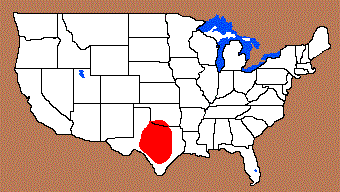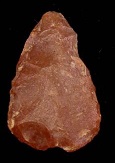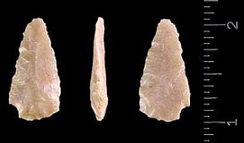Other Websites with Detailed Information:
Name Details:
Named By: Dee Ann Suhm, Alex D. Krieger, Edward B. Jelks
Named For:
Young County, Texas
Date Identified: 1954
Type Site: Multiple
sites in Young County, Texas
Young
Cluster:
Commonly Utilized Material:
Date:
Cultural Period:
700 - 300 B.P.
Late Prehistoric
Little Ice Age
Glacial Period:
Culture:
Outline is Representative of Common Size and Shape:
Description of Physical Characteristics and Flaking Pattern:
This is a small ovoid point with a flattened to uni-facial
cross section. The blade is excurvate with a convex base. This is a crudely made uni-facial point with flaking along the
blade of one face and flaking not generally seen across the face of the worked side.
These points are commonly made of a thin curved flake and has little
work on either side, but more modification on one side over the other.
Size Measurements: Total Length - 25 to
45 mm, Width - 15 to 25 mm (Suhm and Krieger, 1954).
Distribution:
Distribution Comments:
This point is primarily found in Young county
and the upper Brazo river valley and into northern central Texas.
Frequency decreases into central and northern Texas and Oklahoma.

Related / Associated Points:
Additional Comments:
These points are similar to the Catan points, however they are crudely made with chipping only on the edges of one face. This may be the same type as the Catan, just unfinished or poorly made examples.
Due to this, Turner et al. (2011) states that most, if not all, of these are
preforms and not true projectile points.
Other points in this Cluster:
Point Validity: Valid Type
Suhm was an eminent Texas
anthropologist who, among many distinguished positions, served as Director of Texas Archeological Research Laboratory. Krieger was a renowned anthropologist who spent most
of his career in Texas cataloging projectile points and pottery in Texas before moving on to the University of Washington. Jelks was a distinguished anthropologist and
helped organize the newly formed Department of Anthropology at Illinois State University where he was a professor. His work in Texas furthered the understanding of Texas
archeology and was a founding force for the Society of Historical Archeology. This type was named in a professional publication and subsequent book and has many
professional references. This is a valid type.
.
Age Details:
Suhm et al. (1954) states that this type is
common in Henrietta Focus sites and rare in the Central Texas Aspect.
References: (See Reference Page, Entry Number):
8,
23, 30, 115, 178
Young Projectile Point, Young Arrowhead





